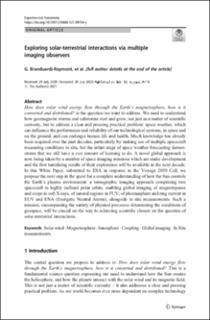| dc.contributor.author | Branduardi-Raymont, Graziella | |
| dc.contributor.author | Berthomier, M | |
| dc.contributor.author | Bogdanova, Y. V. | |
| dc.contributor.author | Carter, Jennifer | |
| dc.contributor.author | Collier, M | |
| dc.contributor.author | Dimmock, A | |
| dc.contributor.author | Dunlop, Malcolm | |
| dc.contributor.author | Fear, Robert C. | |
| dc.contributor.author | Forsyth, Colin | |
| dc.contributor.author | Hubert, Benoit | |
| dc.contributor.author | Kronberg, Elena A. | |
| dc.contributor.author | Laundal, Karl Magnus | |
| dc.contributor.author | Lester, Mark | |
| dc.contributor.author | Oksavik, Kjellmar | |
| dc.contributor.author | Østgaard, Nikolai | |
| dc.contributor.author | Palmroth, Minna | |
| dc.contributor.author | Plaschke, Ferdinand | |
| dc.contributor.author | Porter, F.S. | |
| dc.contributor.author | Rae, I. Jonathan | |
| dc.contributor.author | Read, Andy | |
| dc.contributor.author | Samsonov, A. A. | |
| dc.contributor.author | Sembay, Steven | |
| dc.contributor.author | Shprits, Yuri | |
| dc.contributor.author | Sibeck, David G. | |
| dc.contributor.author | Walsh, Brian | |
| dc.contributor.author | Yamauchi, M | |
| dc.date.accessioned | 2022-04-11T08:53:40Z | |
| dc.date.available | 2022-04-11T08:53:40Z | |
| dc.date.created | 2022-01-17T14:02:21Z | |
| dc.date.issued | 2021 | |
| dc.identifier.issn | 0922-6435 | |
| dc.identifier.uri | https://hdl.handle.net/11250/2990878 | |
| dc.description.abstract | How does solar wind energy flow through the Earth’s magnetosphere, how is it converted and distributed? is the question we want to address. We need to understand how geomagnetic storms and substorms start and grow, not just as a matter of scientific curiosity, but to address a clear and pressing practical problem: space weather, which can influence the performance and reliability of our technological systems, in space and on the ground, and can endanger human life and health. Much knowledge has already been acquired over the past decades, particularly by making use of multiple spacecraft measuring conditions in situ, but the infant stage of space weather forecasting demonstrates that we still have a vast amount of learning to do. A novel global approach is now being taken by a number of space imaging missions which are under development and the first tantalising results of their exploration will be available in the next decade. In this White Paper, submitted to ESA in response to the Voyage 2050 Call, we propose the next step in the quest for a complete understanding of how the Sun controls the Earth’s plasma environment: a tomographic imaging approach comprising two spacecraft in highly inclined polar orbits, enabling global imaging of magnetopause and cusps in soft X-rays, of auroral regions in FUV, of plasmasphere and ring current in EUV and ENA (Energetic Neutral Atoms), alongside in situ measurements. Such a mission, encompassing the variety of physical processes determining the conditions of geospace, will be crucial on the way to achieving scientific closure on the question of solar-terrestrial interactions. | en_US |
| dc.language.iso | eng | en_US |
| dc.publisher | Springer | en_US |
| dc.relation.uri | https://link.springer.com/article/10.1007%2Fs10686-021-09784-y | |
| dc.rights | Navngivelse 4.0 Internasjonal | * |
| dc.rights.uri | http://creativecommons.org/licenses/by/4.0/deed.no | * |
| dc.title | Exploring solar-terrestrial interactions via multiple imaging observers | en_US |
| dc.type | Journal article | en_US |
| dc.type | Peer reviewed | en_US |
| dc.description.version | publishedVersion | en_US |
| dc.rights.holder | Copyright 2021 The Author(s) | en_US |
| cristin.ispublished | true | |
| cristin.fulltext | original | |
| cristin.qualitycode | 1 | |
| dc.identifier.doi | 10.1007/s10686-021-09784-y | |
| dc.identifier.cristin | 1982631 | |
| dc.source.journal | Experimental astronomy (Print) | en_US |
| dc.relation.project | Norges forskningsråd: 223252 | en_US |
| dc.identifier.citation | Experimental astronomy. 2021 | en_US |

